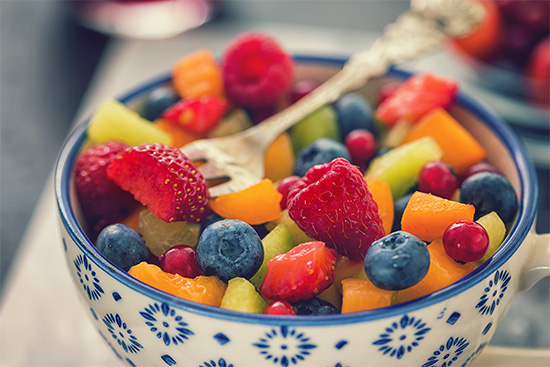About The Buzz: Fruit & Vegetable Headlines

WHAT THEY’RE SAYING
Myricetin, a flavonoid found in fruit and vegetables, has been shown to protect cells against damage caused by ultraviolet radiation (UV) from sun exposure.1
WHAT THIS MEANS
Flavonoids are naturally-occurring compounds found in fruit, vegetables, chocolate, wine and tea.2 These compounds regulate important functions in plants, such as attracting pollinating insects and regulating cell growth.2 In recent years, flavonoids have gained attention due to their potential beneficial impacts on human health. Some studies have demonstrated that flavonoids may reduce inflammation; reduce the risk of diabetes and cardiovascular disease; and benefit cognitive function.
WHY THIS MATTERS
UV exposure from sunlight is a primary risk factor for most skin cancers.3 UV rays harm skin cells by damaging their DNA and disrupting the genes that regulate cell growth.3 A recent study explored the potential beneficial effects of a flavonoid, myricetin, on skin cells exposed to UV damage.
Myricetin is found in walnuts, onions, berries, herbs and red grapes.4 This flavonoid has antioxidant properties, including free radical scavenging.4 Free radicals are formed naturally by the body through normal metabolic processes or through environmental exposure to X-rays, cigarette smoking, air pollutants or industrial chemicals.5 Free radicals are highly reactive and wreak havoc on cells by damaging their DNA.5 Antioxidants work to combat free radical damage and reduce their ability to harm cells. When an imbalance between free radical formation and antioxidant defense occurs, the outcome is oxidative stress.5 Oxidative stress is understood to contribute to inflammatory conditions, hypertension, cancers, heart disease, alcoholism, smoking-related diseases and many other diseases.5
WHAT THE RESEARCH SHOWS
A recent study evaluated the protective effects of myricetin on UVB-induced cell damage. UVB rays damage cell DNA directly and are the main cause of sunburns and thought to increase the risk of the most skin cancers.3 Researchers exposed all cells to UVB radiation and then separated cells into a myricetin group and a control group (no myricetin treatment). Lower doses of myricetin showed no protective effect against UVB, but higher doses resulted in an 80% cell survival rate. This study demonstrated the beneficial effects of myricetin, primarily through its ability to protect cells against UV-induced free radicals and suppress inflammatory response from UV exposure.
THE BOTTOM LINE
The results of this study indicate that myricetin may play an important role in reducing the harmful effects of UVB exposure on cells. These findings could contribute to the development of pharmaceutical and cosmetic products targeted at reducing the risk of skin cancer.
Additionally, this study provides further insight onto the extensive health benefits of a diets rich in fruit and vegetables. Fruit and vegetables are rich in antioxidants, fiber, vitamins, and minerals that keep your body and mind healthy. Remember to fill half your plate with fruit and veggies during every meal and aim to make your plate rainbow of color.

Join America’s More Matters Pledge to Fight Obesity
The obesity rate in American children has tripled over the past 30 years, and their expected lifespan is now less than their parents! There are things you can do at home … and at school … to help change this!
Take the PLEDGE – Let Us Help You Stop this Trend!
Video Center: Selection. Storage. Preparation.
How Many Cups Do You Need?
Key Nutrients in Fruits & Vegetables
Fruit & Veggie Database


